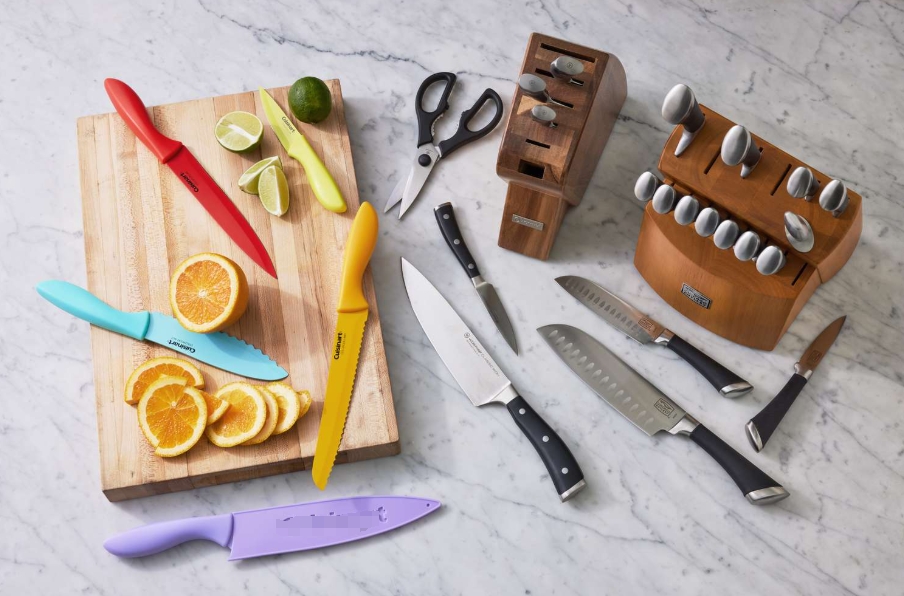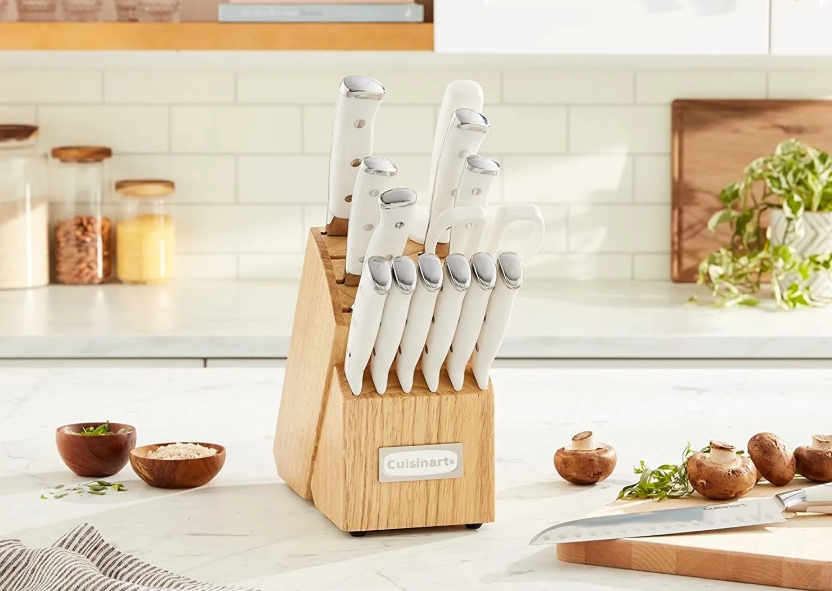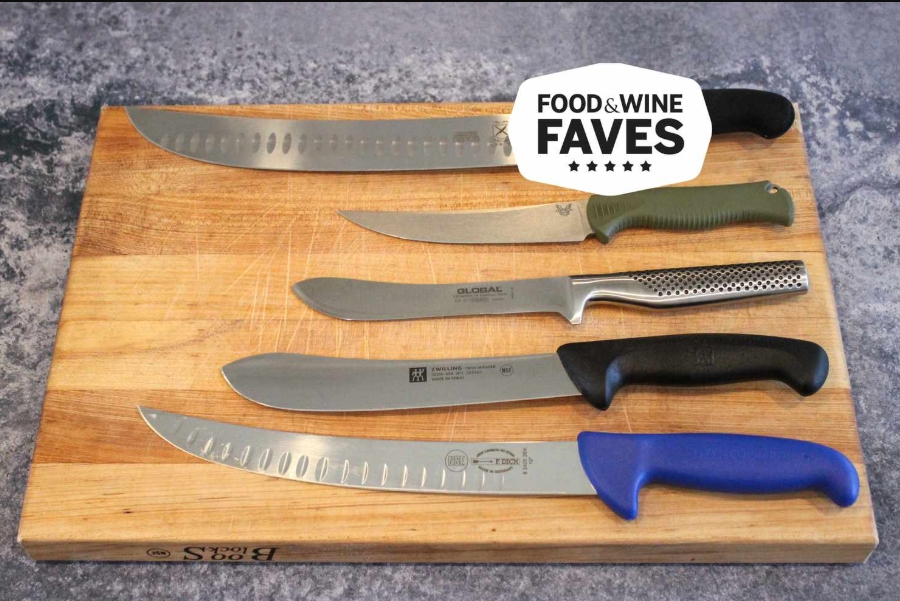

Views: 222 Author: Ella Publish Time: 2025-04-22 Origin: Site








Content Menu
● Understanding Knife Steel Basics
>> Drawbacks
>> Drawbacks
● Head-to-Head Comparison: High Carbon vs Stainless Steel
● Cost and Value Considerations
● Choosing the Right Knife for You
● FAQ: High Carbon vs Stainless Steel Kitchen Knives
>> 1. Which knife stays sharper longer: high carbon or stainless steel?
>> 2. Are stainless steel knives truly rust-proof?
>> 3. Is it difficult to sharpen stainless steel knives?
>> 4. Why do some chefs prefer high carbon steel despite the maintenance?
>> 5. Can I use both types of knives in my kitchen?
Kitchen knives are the backbone of every culinary adventure, and the material of your blade can make a world of difference in performance, maintenance, and longevity. Two of the most debated types are high carbon steel and stainless steel. This comprehensive guide explores the science, craftsmanship, and practical realities behind both, helping you make an informed choice for your kitchen.

Before diving into the differences, it's important to understand what makes up the steel in your kitchen knife.
- Steel is an alloy primarily composed of iron and carbon.
- High Carbon Steel contains a higher percentage of carbon (typically 0.6% to 1.5%), which affects hardness and edge retention[10].
- Stainless Steel includes at least 10.5% chromium, making it resistant to rust and staining[10].
Different steel compositions lead to unique characteristics in sharpness, durability, and maintenance.
High carbon steel is revered among professional chefs and knife enthusiasts. Its defining feature is a higher carbon content, which imparts several key attributes:
- Hardness: High carbon steel is harder than most stainless steels, allowing for an exceptionally sharp edge and superior edge retention[10][2].
- Sharpness: These knives can be honed to a razor-sharp edge, making precision cuts effortless[3][2].
- Edge Retention: The hardness means the blade stays sharp longer, reducing the frequency of sharpening[2][10].
- Responsiveness: High carbon blades are responsive to sharpening stones, making them easier to sharpen for those with experience[3][7].
- Corrosion Prone: Lacking chromium, high carbon steel is highly susceptible to rust and discoloration if not properly cared for[4][6].
- Brittleness: The increased hardness can make the blade more brittle, increasing the risk of chipping or breaking if misused[10][2].
- Maintenance: Requires immediate cleaning and drying after use, and regular oiling to prevent rust[4][11].
Stainless steel knives are a staple in home and professional kitchens worldwide. Their main advantage lies in their composition:
- Corrosion Resistance: The addition of chromium forms a protective oxide layer, making these knives highly resistant to rust and staining—even in humid or wet environments[1][10].
- Durability: Stainless steel is more flexible and less brittle, making it less likely to chip or break under stress[1][10].
- Low Maintenance: These knives are easy to care for, requiring only basic cleaning and drying after use[1][6].
- Versatility: Suitable for a wide range of kitchen tasks, from slicing vegetables to chopping through tougher ingredients[10].
- Edge Retention: Generally, stainless steel knives lose their edge faster than high carbon counterparts and require more frequent sharpening[10][2].
- Sharpness: While modern stainless steels can be very sharp, they typically cannot achieve or maintain the same razor-sharp edge as high carbon steel[1][6].
- Sharpening Difficulty: Stainless steel is tougher to sharpen, often requiring specialized tools or more effort[10][7].
| Feature | High Carbon Steel | Stainless Steel |
|---|---|---|
| Sharpness | Superior, razor-sharp edge | Very sharp, but not as fine |
| Edge Retention | Excellent, stays sharp longer | Good, but dulls faster |
| Hardness | Harder, can be brittle | Softer, more flexible |
| Corrosion Resistance | Poor, rusts easily | Excellent, resists rust and stains |
| Maintenance | High (clean, dry, oil regularly) | Low (basic cleaning and drying) |
| Ease of Sharpening | Easier with stones | More difficult, may need pro tools |
| Durability | Can chip if misused | Less likely to chip, more forgiving |
| Cost | Varies, often less expensive | Varies, often more expensive |
| Aesthetic Aging | Develops patina, unique character | Maintains shine, less character |
- Precision: Ideal for tasks that require extreme sharpness and control, such as fine slicing, filleting, and dicing[3][2].
- Speed: The keen edge allows for faster, more efficient prep work, favored by professional chefs[2][5].
- Patina: Over time, high carbon knives develop a unique patina—a grayish layer that both protects the blade and tells the story of your culinary journey[5].
- Versatility: Handles a wide variety of kitchen tasks without fear of rust or corrosion[1][10].
- Forgiveness: More forgiving of mistakes, such as leaving the knife wet or using it on harder surfaces[1][10].
- Consistency: Maintains a clean, polished look with minimal effort, making it ideal for busy home cooks[1][6].
- Clean Immediately: Wash and dry right after use to prevent rust and staining[4][11].
- Oil Regularly: Apply a thin layer of food-safe mineral oil to protect the blade[4].
- Sharpen with Stones: Responds well to whetstones and honing rods, making it easy to maintain a keen edge[3][7].
- Develop Patina: Embrace the patina as a sign of proper use and care—it adds character and a layer of protection[5].
- Basic Cleaning: Rinse and dry after use; dishwasher safe for some models, but hand washing is recommended[1][6].
- Minimal Oiling: Rarely needs oiling due to chromium content[1].
- Sharpening: May require diamond or ceramic sharpeners for best results, as the steel is tougher[10][7].
- Long-Term Shine: Maintains a bright, shiny appearance with little effort[1][6].

- High Carbon Steel: Often more affordable, especially in traditional Japanese or artisanal knives. The lower cost comes with the trade-off of higher maintenance[2][5].
- Stainless Steel: Can range from budget-friendly to premium, especially with advanced alloys. The added convenience and durability often justify the higher price for many users[1][5].
The best knife is the one that fits your cooking style, maintenance preferences, and budget.
Choose High Carbon Steel If:
- You value razor-sharpness and edge retention above all[2][3].
- You're willing to invest time in maintenance and care[4][11].
- You enjoy the unique character a patina brings to your tools[5].
Choose Stainless Steel If:
- You want a low-maintenance, rust-resistant knife[1][6].
- You need a versatile tool for a variety of kitchen tasks[10].
- You prefer a blade that stays shiny and clean with minimal effort[1].
Both high carbon and stainless steel kitchen knives have their place in the modern kitchen. High carbon steel offers unparalleled sharpness and edge retention, making it a favorite among chefs who value precision and are willing to invest in maintenance. Stainless steel, on the other hand, provides durability, rust resistance, and ease of care—perfect for busy home cooks and professionals alike.
Ultimately, the choice comes down to your cooking habits, willingness to maintain your tools, and personal preferences. Many serious cooks own both types, using each where it excels. Whichever you choose, proper care and sharpening will ensure your knife serves you well for years to come.

High carbon steel knives generally stay sharper longer due to their higher hardness and superior edge retention. However, they require more maintenance to prevent rust and chipping[10][2][6].
Stainless steel knives are highly resistant to rust thanks to their chromium content, but they are not entirely rust-proof. Prolonged exposure to moisture or acidic foods can still cause staining or minor corrosion over time[1][10].
Yes, stainless steel knives are generally tougher to sharpen than high carbon steel knives. They may require diamond or ceramic sharpening tools, and the process can take longer[10][7].
Many chefs prefer high carbon steel for its razor-sharp edge, superior cutting performance, and the unique patina that develops with use. For those who appreciate craftsmanship and performance, the extra maintenance is a worthwhile trade-off[2][5][3].
Absolutely. Many cooks keep both high carbon and stainless steel knives, using each for tasks where they excel. High carbon is great for precision work, while stainless steel is ideal for heavy-duty or wet tasks[1][10][6].
[1] https://www.thewildestroad.com/blog/carbon-vs-stainless-steel-knives
[2] https://hasuseizo.com/blogs/japanese-kitchen-knives/3-stainless-steel-knives-vs-high-carbon-steel-knives
[3] https://knife-life.jp/blog/main-advantages-of-high-carbon-steel-knives/
[4] https://www.hunker.com/13412243/advantages-disadvantages-of-high-carbon-steel-kitchen-knives/
[5] https://www.seriouseats.com/why-buy-carbon-steel-knives-best-kitchen-tools
[6] https://foldedsteel.com/blogs/learn-chef-knives/high-carbon-vs-stainless-time-to-cut-the-debate
[7] https://www.reddit.com/r/chefknives/comments/bz0e9f/are_carbon_steel_really_better_than_stainless/
[8] https://cooking.stackexchange.com/questions/29983/why-would-i-prefer-carbon-steel-rust-prone-kitchen-knife
[9] https://msicardcutlery.com/knife-making-steel-information-faq/
[10] https://www.opinel-usa.com/blogs/news/stainless-steel-vs-carbon-steel-knives
[11] https://elementknife.com/pages/common-questions-about-kitchen-knives
[12] https://www.chefs-edge.com.au/blogs/knife-information/carbon-steel-v-stainless-steel-whats-better
[13] https://knifewear.com/blogs/articles/carbon-steel-knives-v-s-stainless-steel-knives-which-is-better
[14] https://seidoknives.com/blogs/news/carbon-steel-vs-stainless-steel
[15] https://www.opinel.com/en/opinel-and-me/news/opinel-knife-carbon-or-stainless-steel-blade
[16] https://knifepivotlube.com/blogs/knife-pivot-lube/pros-and-cons-of-high-carbon-steel
[17] https://towncutler.com/blogs/town-cutler-blog/carbon-v-stainless-steel-what-you-need-to-know
[18] https://www.koiknives.com/blogs/japanese-knives/what-does-carbon-do-to-your-knife
[19] https://wasabi-knives.com/blogs/news/carbon-or-stainless-steel-all-you-need-to-know
[20] https://www.koiknives.com/blogs/japanese-knives/stainless-steel-vs-carbon-steel
[21] https://www.koiknives.com/blogs/japanese-knives/high-carbon-vs-stainless-steel-understanding-the-properties
[22] https://www.chefs-edge.com.au/blogs/knife-care/the-definitive-guide-to-japanese-knife-steels
[23] https://www.montanaknifecompany.com/blogs/news/carbon-steel-vs-stainless-steel
[24] https://cutleryandmore.com/collections/carbon-steel-knives
[25] https://www.steelportknife.com
[26] https://japanesechefsknife.com/collections/high-carbon-steel
[27] https://www.youtube.com/watch?v=_OIlRGDkGSs
[28] https://www.youtube.com/watch?v=3XFTmB-OFs4
[29] https://www.reddit.com/r/chefknives/comments/uq0deu/carbon_steel_vs_stainless_edge_sharpness/
[30] https://www.shutterstock.com/search/carbon-steel-knife
[31] https://www.shutterstock.com/search/stainless-steel-knife
[32] https://www.reddit.com/r/knives/comments/16ir6u7/carbon_steel_vs_stainless_steel/
[33] https://knifesteelnerds.com/2021/10/19/knife-steels-rated-by-a-metallurgist-toughness-edge-retention-and-corrosion-resistance/
[34] https://www.youtube.com/watch?v=idsg1KDgk6c
[35] https://www.sabatier-shop.com/carbon-steel-knives.html
[36] https://www.thewildestroad.com/blog/carbon-vs-stainless-steel-knives
[37] https://www.kitchenknifeforums.com/threads/stainless-vs-carbon-steel.51083/
[38] https://capecodcutlery.com/care-and-cleaning-of-knives/
[39] https://www.knivesandtools.com/en/ct/steel-types-for-kitchen-knives.htm
[40] https://www.youtube.com/watch?v=d8jvqrVRMQI
[41] https://www.reddit.com/r/chefknives/comments/rm915m/carbon_knives_and_you_guide/
[42] https://www.bladesmithsforum.com/index.php?%2Ftopic%2F36510-some-stainless-questions%2F&do=findComment&comment=354716
[43] https://www.knivesandtools.com/en/ct/knife-steel-types-and-information.htm
[44] https://www.marathontrainingacademy.com/what-are-some-dangers-of-a-stainless-steel-knife
[45] https://www.seriouseats.com/why-buy-carbon-steel-knives-best-kitchen-tools
[46] https://hasuseizo.com/collections/high-carbon
[47] https://www.messermeister.com/collections/carbon
[48] https://japanesechefsknife.com/collections/damascus-stainless-steel
[49] https://www.reddit.com/r/chefknives/comments/k5cz6u/it_seems_like_chef_knives_use_different_steels/
[50] https://www.youtube.com/watch?v=Rp47a68YgqI
[51] https://sabatierknifeshop.com/products/8-pc-kitchen-knives-set-with-color-choice
[52] https://dalstrong.com/blogs/news/a-comprehensive-guide-to-the-different-types-of-knife-steel
What's the Difference Between a Kitchen Knife and a Carving Knife?
What's the Difference Between a Paring Knife and a Kitchen Knife?
What's the Difference Between High Carbon and Stainless Steel Kitchen Knives?
What's the Difference Between Forged and Stamped Kitchen Knives?
What's the Difference Between a Chef's Knife and a Kitchen Knife?